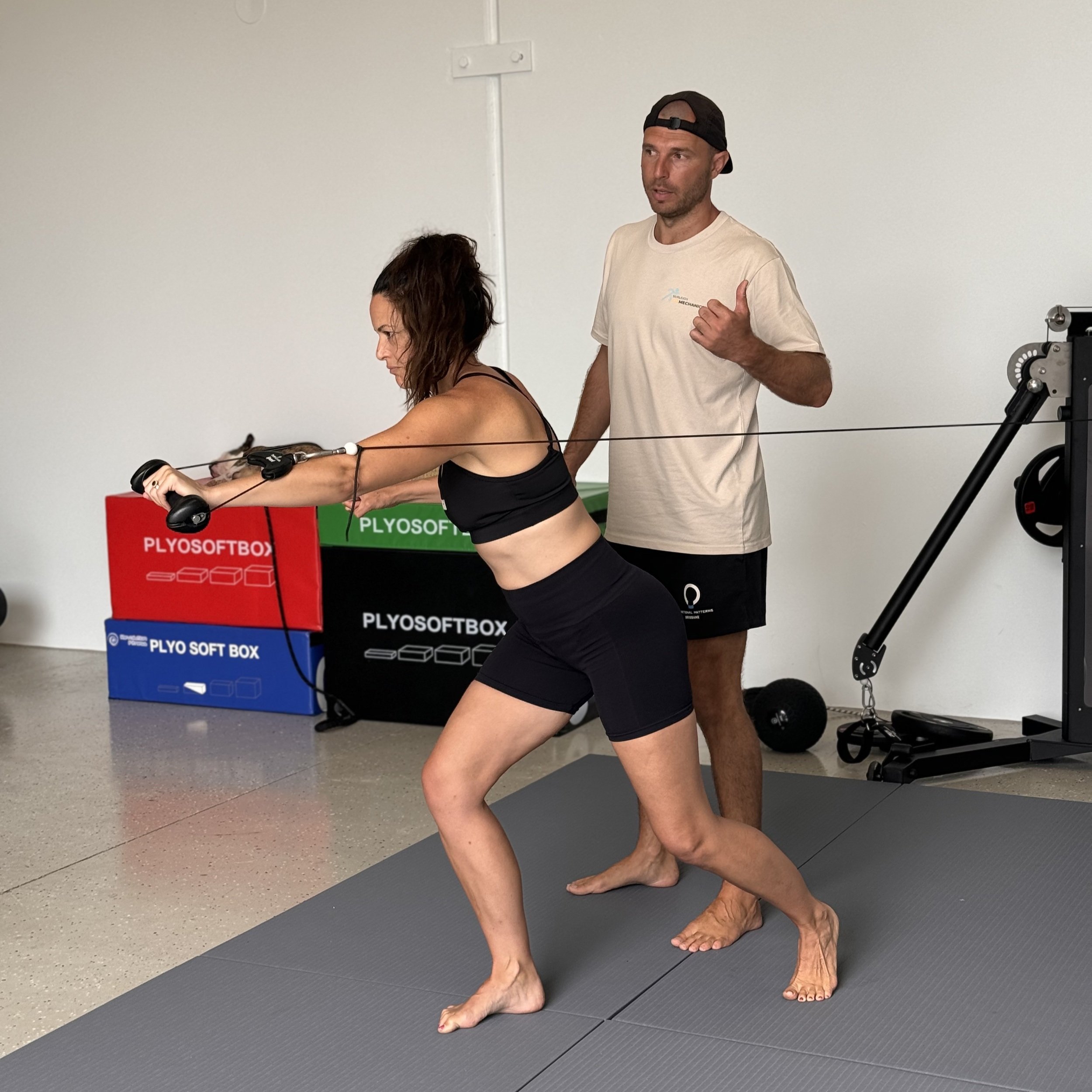Beyond Clinical Pilates: Why Functional Biomechanics Outperforms Reformer Routines
If you’ve ever searched “clinical Pilates near me” around the Gold Coast, you’ve probably been told it’s the gold standard for posture, back pain, and rehabilitation. It’s structured, safe, and designed by physiotherapists — at least that’s how it’s marketed.
But as more people cycle through reformer studios across Burleigh Heads without lasting change, it’s clear something is missing. At Burleigh Biomechanics, we work with locals who’ve done years of Pilates and still struggle with pain, asymmetry, or instability. The reason isn’t effort — it’s the mechanics.
Functional Patterns VS Clinical Pilates
What Is Clinical Pilates Really Trying to Do?
Clinical Pilates was originally created to bridge the gap between rehab and exercise. The idea was simple: strengthen your “core,” improve flexibility, and stabilise the spine to prevent injury. It sounds great in theory — but in practice, it’s built on static alignment rather than dynamic integration.
When you’re lying on your back, isolated from gravity, you can make muscles stronger — but you’re not teaching the body to coordinate under load, rotate, or manage momentum. That’s why people often leave a Pilates session feeling “activated” but still move the same way when they walk or run.
That’s why many of our Burleigh Heads clients come to us after months of reformer classes that didn’t translate into better posture, less pain, or better movement in daily life.
The Problem With Reformer Routines
The reformer is a clever tool, but it traps the body in linear movement patterns. Springs and straps add resistance, but they also remove the variability your nervous system needs to adapt to real-world forces.
In other words — the reformer teaches you how to move on a reformer, not how to move in life.
Over time, this can reinforce the very dysfunctions that caused pain in the first place:
Over-recruitment of hip flexors and rectus abdominis
Weak or mis-timed glute activation
Poor sequencing through the thoracic and pelvic regions
Disconnected fascial chains that can’t transfer force efficiently
The body might look more toned, but the movement system underneath is still fragmented.
Why Functional Biomechanics Works Differently
Functional Biomechanics — the foundation of Functional Patterns — reverses that hierarchy.
We don’t start with “core activation”; we start with how you stand, walk, and breathe. Those are the patterns that shape every muscle and joint load you experience.
By addressing gait mechanics and rotational sequencing, we restore the natural spirals and tension lines that stabilise your body dynamically — not by clenching, but by coordinating.
That’s why our clients across the Gold Coast often find that their posture improves without ever thinking about posture. Their spine aligns because the muscles surrounding it finally know how to share force.
Clinical Pilates vs Functional Biomechanics
Clinical PilatesFunctional BiomechanicsGoalStrengthen isolated musclesIntegrate full-body systemsMethodReformer-based, linear movementGravity-based, gait-driven movementFocusCore stabilityWhole-body force distributionOutcomeFeels good, temporary reliefSustainable change, measurable improvement
Many people who visit our Burleigh Heads biomechanics facility have done reformer Pilates or traditional physiotherapy with limited success. Once they see how the pelvis, ribcage, and shoulder girdle interact in motion, the dots connect — and pain stops being random.
The Missing Link: Integration Over Isolation
Your body doesn’t work in parts, and yet most of modern rehabilitation still trains that way. Muscles don’t operate in isolation; they function as part of a tensegrity network. When one region moves, another responds.
Functional Biomechanics teaches the body to share tension intelligently. It’s not about doing more reps or holding longer planks — it’s about restoring efficient communication between muscles, fascia, and the nervous system.
When that happens, old injuries stop reappearing. Energy efficiency improves. Movement becomes lighter, faster, and more symmetrical — because your system is finally coherent.
Why Burleigh Biomechanics Takes a Different Path
We’re not anti-Pilates. We’re anti-stagnation. If reformer work helped you move again, great — but it’s just a starting point. The next step is to rebuild how your body transfers force through the gait cycle.
At Burleigh Biomechanics, located in the heart of Burleigh Heads on the Gold Coast, our sessions are built around:
Gait analysis and correction to identify inefficiencies
Integration drills that restore hip–shoulder coordination
Strength under rotation and load — the way you actually move in life
The goal isn’t to activate more muscles. It’s to activate the right ones, at the right time, in the right sequence.
The Future of Movement Rehabilitation
“Clinical” once meant scientific. Today, it often means rigid and outdated. The future of rehabilitation isn’t more machines or classes — it’s principle-based movement.
Functional Biomechanics brings together physics, neurology, and fascia-based tensioning to help your body do what it evolved to do: move efficiently through space.
If you’ve plateaued with Clinical Pilates, this is the step beyond.
👉 Book a Biomechanical Assessment
and experience why Burleigh Heads locals are choosing biomechanics over traditional Pilates or physio for lasting results.







